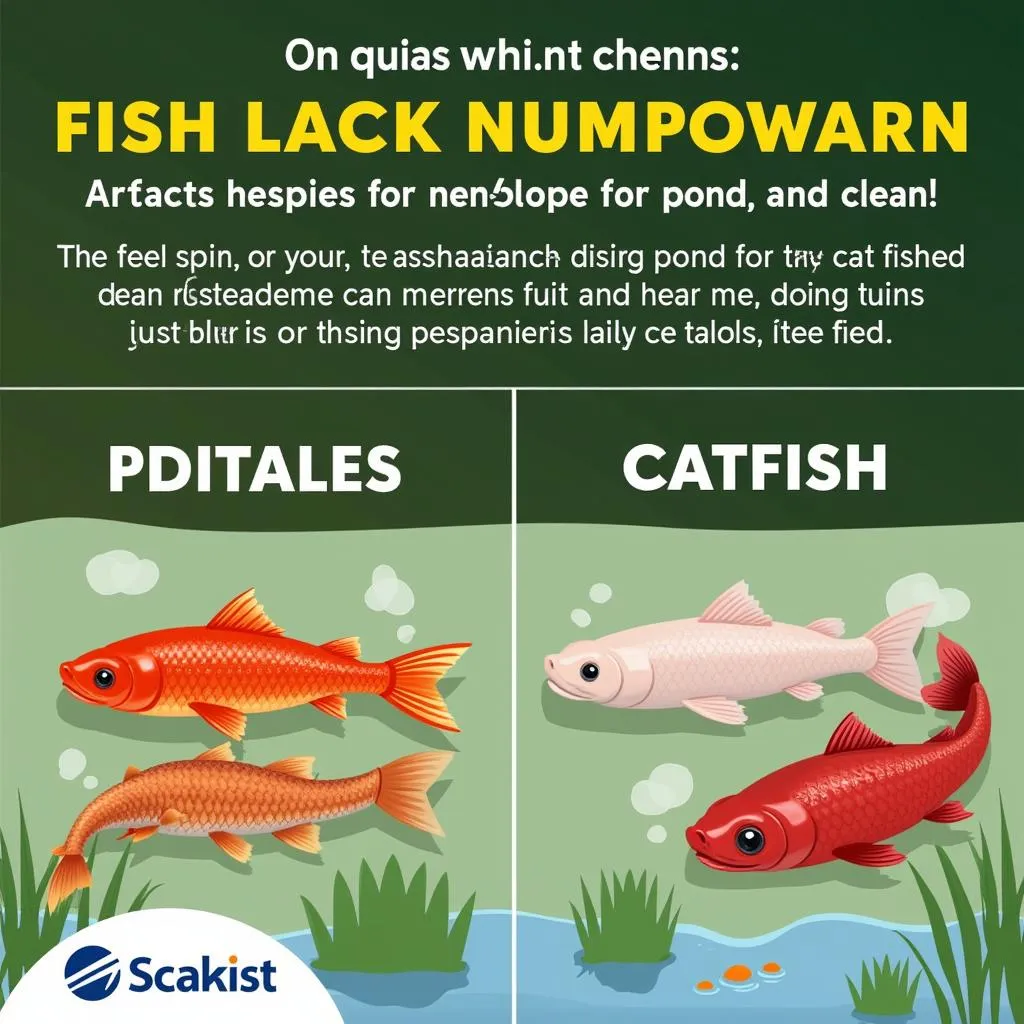Catfish are a popular choice for pond owners, known for their hardiness and ability to thrive in a variety of conditions. But like any fish, they require the right diet to stay healthy and happy. This guide will delve into the essential aspects of feeding catfish in a pond, providing valuable insights to ensure the well-being of your finned friends.
The Basics of Catfish Nutrition
Catfish are omnivores, meaning they consume both plant and animal matter. Their diet should include a mix of these elements to ensure proper growth and development.
What Do Catfish Eat in the Wild?
In their natural habitat, catfish forage for a wide range of food sources, including:
- Aquatic insects: Mosquito larvae, midge larvae, and other insect nymphs are crucial protein sources for growing catfish.
- Small crustaceans: Crayfish, shrimp, and other small crustaceans provide valuable nutrients and promote healthy development.
- Algae and vegetation: Catfish also consume algae, water plants, and decaying plant matter, contributing to a balanced diet.
- Fish eggs and larvae: During spawning season, catfish may consume eggs and larvae of other fish species, adding further diversity to their diet.
Understanding Your Catfish’s Dietary Needs
The specific dietary needs of your catfish will depend on their age, size, and activity level. Young catfish require a higher protein content for rapid growth, while larger, mature catfish may require a more balanced diet.
Feeding Your Catfish in a Pond
Now that we understand the basics of catfish nutrition, let’s dive into the best practices for feeding your catfish in a pond.
What to Feed Your Catfish
There are several options for feeding your catfish in a pond:
- Commercial catfish pellets: These readily available pellets are formulated with the specific nutritional needs of catfish in mind. They offer a balanced mix of protein, carbohydrates, and fats, and come in different sizes to suit catfish of various ages.
- Live food: Offering live food like worms, crickets, and aquatic insects can enhance the natural feeding instincts of your catfish. However, ensure the live food is free of parasites and diseases to prevent contamination.
- Supplemental food: To supplement their diet, you can occasionally add chopped vegetables like spinach, zucchini, and sweet potatoes to their feeding areas. However, avoid overfeeding, as excess food can pollute the pond water.
How to Feed Your Catfish
- Regular feeding schedule: Establish a regular feeding schedule, typically once or twice a day, depending on the size and activity of your catfish.
- Avoid overfeeding: Overfeeding can lead to water pollution, excess algae growth, and a decrease in water quality. Only feed the amount your catfish can consume within a few minutes.
- Distribution: Scatter the food evenly throughout the pond, ensuring that all catfish have access to the food.
- Observation: Observe your catfish while feeding. If they are not eating readily, consider adjusting the type or amount of food.
Tips for Feeding Your Catfish in a Pond
- Provide hiding places: Catfish are natural scavengers and enjoy hiding in crevices or beneath rocks. Adding hiding spots will encourage them to forage naturally and reduce stress.
- Monitor water quality: Ensure your pond water is clean and healthy. Regular testing and water changes can prevent diseases and maintain a balanced ecosystem.
- Consider a pond aeration system: Aeration systems provide oxygen to the pond water, which is especially important for catfish during warmer months.
- Seek professional advice: If you have any concerns about your catfish’s health or feeding habits, consult a veterinarian or fish expert.
Common Catfish Feeding Questions
Q: What is the best time of day to feed my catfish?
A: Morning or evening are generally the best times to feed catfish, as they are more active at these times.
Q: Can I feed my catfish table scraps?
A: It’s best to avoid feeding your catfish table scraps. While they may eat them, these scraps often lack the necessary nutrients and can be harmful to their health.
Q: How do I know if I’m overfeeding my catfish?
A: If you see uneaten food accumulating at the bottom of the pond or notice a cloudy or murky water, you may be overfeeding your catfish.
Q: What are the signs of a healthy catfish?
A: A healthy catfish will be active, have bright, clear eyes, and a healthy appetite.
Q: What can I do if my catfish are not eating?
A: If your catfish are not eating, it could be a sign of illness or water quality issues. Consult a veterinarian or fish expert for diagnosis and treatment.
Feeding Catfish for a Thriving Pond
By following these guidelines and understanding the dietary needs of catfish, you can ensure that your pond is a healthy and vibrant environment for your fish. Remember to observe your catfish carefully and make adjustments to their diet and feeding habits as needed.
 Catfish enjoying a meal in a pond
Catfish enjoying a meal in a pond
By providing the right food and maintaining a healthy environment, you can create a thriving pond where your catfish can flourish. If you require further assistance, contact us at 02437655121, Email: [email protected] or visit us at 3PGH+8R9, ĐT70A, thôn Trung, Bắc Từ Liêm, Hà Nội, Việt Nam. Our team is available 24/7 to answer your questions and provide expert advice.